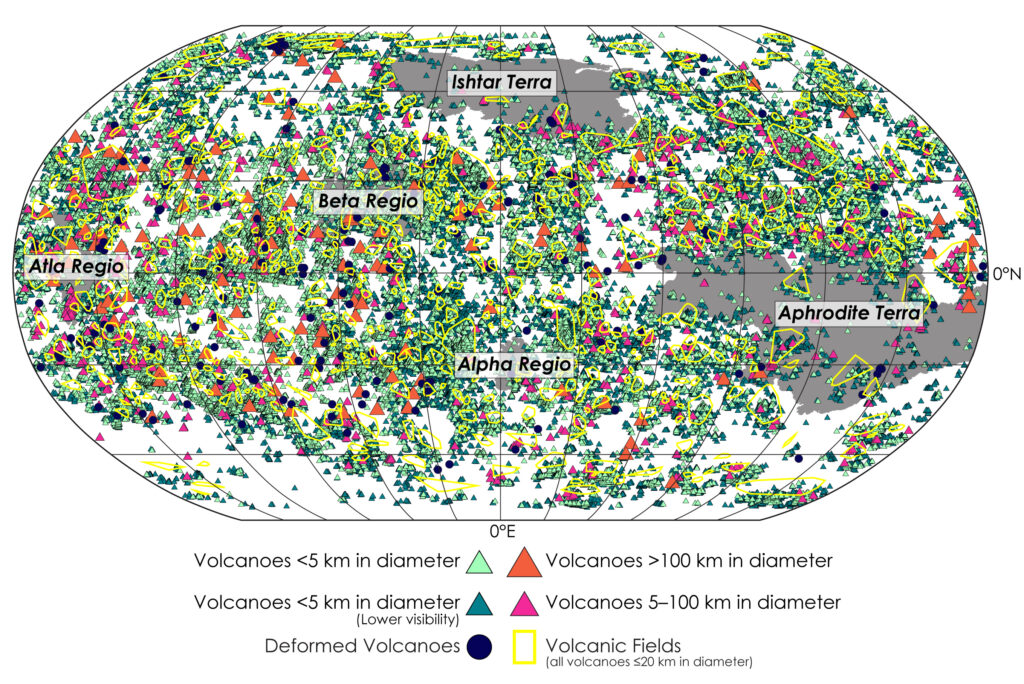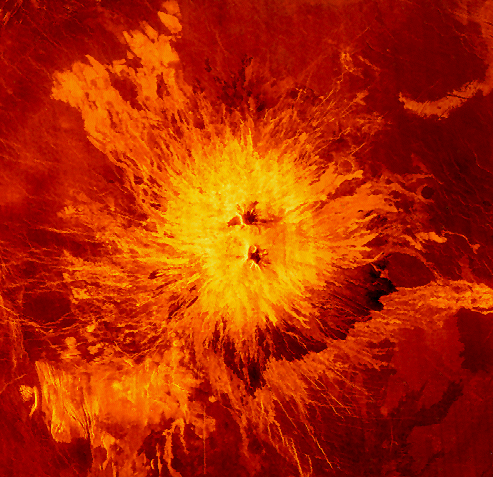85,000 volcanoes on Venus
You are planning a trip to Venus? Then you’d better avoid the numerous volcanoes there. This works better with good map material, as it is now finally available: Planetologists Paul Byrne and Rebecca Hahn from Washington University have counted 85,000 volcanoes on our neighboring planet Venus – and entered them on a map for the first time. The accompanying database is publicly available.
“This work is the most comprehensive map of all volcanic structures on Venus ever produced,” says Byrne, associate professor of earth and planetary sciences at Washington University in St. Louis. “It provides researchers with an enormously valuable database for understanding volcanism on this planet – an important planetary process, but one we know very little about on Venus, even though it’s a world the same size as our own.”
Byrne and Hahn used radar images from NASA’s Magellan mission to catalog volcanoes on Venus on a global scale. Of the 85,000 volcanoes, about 99 percent are less than 5 kilometers in diameter.
“We came up with the idea of doing a global catalog because no one has done it on this scale before,” says Hahn, a doctoral student in Earth and planetary sciences at the University of Washington and lead author of the new study. “It was tedious, but I had experience with the ArcGIS software that I used to create the map. When this data first became available in the 1990s, this tool didn’t exist. Back then, people drew circles around volcanoes by hand, whereas now I can just do it on the computer.”
Byrne and Hahn’s new study includes detailed analyses of where volcanoes are located, where and how they cluster, and how their spatial distribution relates to planetary geophysical properties such as the thickness of the Earth’s crust. Overall, this work provides the most comprehensive understanding to date of the volcanic properties of Venus – and perhaps even our Earth. For although we already know much about terrestrial volcanoes on land, there are probably still very many waiting to be discovered in the oceans. Since Venus has no oceans of its own, its entire surface can be viewed with Magellan radar images.
Although there are volcanoes on almost the entire surface of Venus, the scientists found relatively few volcanoes, ranging from 20 to 100 km in diameter, which they believe may be related to the availability of magma and the rate of eruption. Byrne and Hahn also wanted to take a closer look at smaller volcanoes on Venus, those less than 5 kilometers in diameter that have been overlooked by previous volcano hunters.
“They are the most common volcanic feature on the planet: They make up about 99% of my data set,” Hahn said. “We looked at their distribution using various spatial statistics to see if volcanoes cluster around other structures on Venus or if they’re located in specific areas.”
And while 85,000 volcanoes on Venus may seem like a large number, Hahn says that figure is rather conservative. She believes there are hundreds of thousands of additional geologic features with volcanic characteristics lurking on the surface of Venus. They’re just too small to be discovered. “A volcano 1 kilometer in diameter in the Magellan data would have a diameter of 7 pixels on the image, which is really hard to detect,” Hahn said. “But with improved resolution, we could resolve these structures.” “NASA and ESA will each send a mission to Venus in the early 2030s to take high-resolution radar images of the surface,” Byrne said. “With these images, we will be able to look for the smaller volcanoes.”

